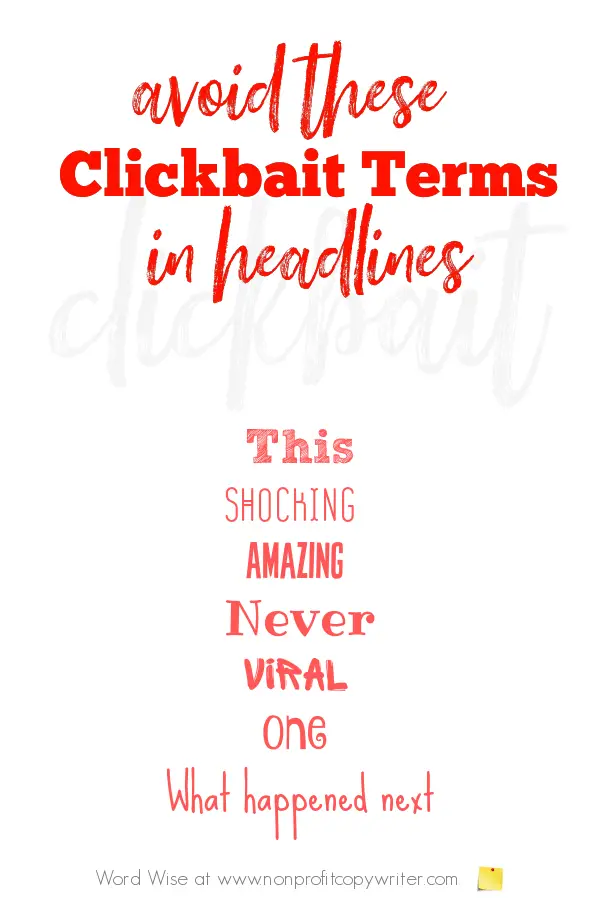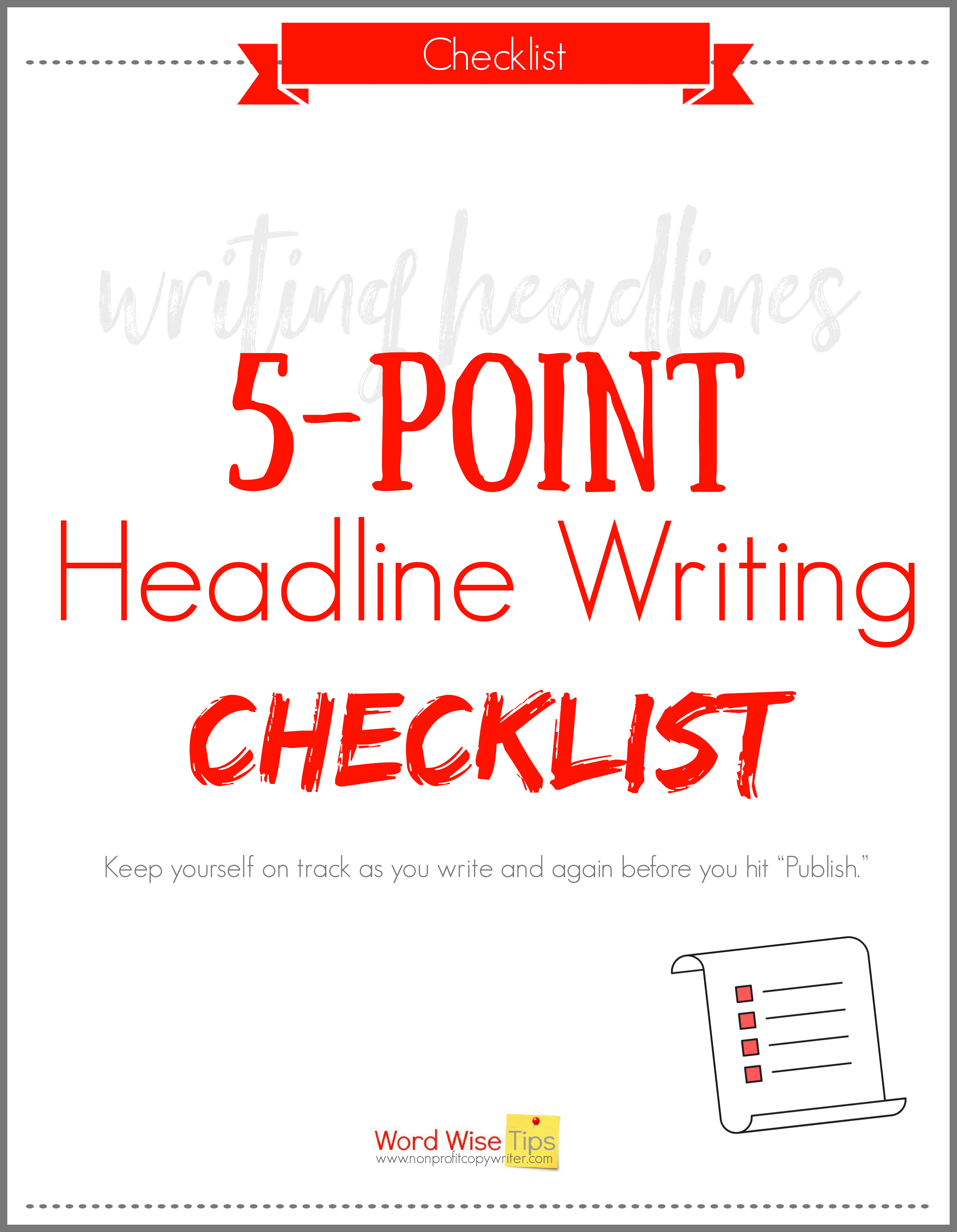Save Time: Get 5 Simple Writing Tips
you can put to use in 10 minutes
The Problem with Clickbait Headlines
Award-winning writer Kathy Widenhouse has helped hundreds of nonprofits and writers produce successful content , with 750K+ views for her writing tutorials. She is the author of 9 books. See more of Kathy’s content here.
Updated 2.13.25
Clickbait headlines are sensationalized or exaggerated titles.
You can find clickbait on blog posts, in article titles, and most plentifully on social media. In fact, Facebook faced down the rise of clickbait in its 2017 algorithm update. “People tell us they don’t like stories that are misleading, sensational, or spammy,” say the app’s engineers. “That includes clickbait headlines that are designed to get attention and lure visitors into clicking on a link.”
But a headline’s job is to get attention, right? If the reader doesn’t get beyond the headline, then they won’t read the piece. Online, that means a headline’s role is to get the click.
So, you’d think that clickbait headlines would get respect. They achieve the desired result: traffic. Any self-respecting blogger or digital content writer wants to get clicks to a website. I know I do.
But there’s a problem with clickbait that goes beyond the ability to drive traffic. Clickbait headlines get the click … but in a sneaky way.
For instance, a clickbait headline shouts out an Amazing solution to your lifelong problem. Once you click and you arrive at the site, you must wade through 47 slides to find that the answer is eating a banana a day or changing your car’s motor oil every 5,000 miles — answers that you knew all along. If you’re like me, you grind your teeth in frustration.
At issue here is not the need to get the reader to click. Rather, it’s what clickbait leads to: a page that has little consequence. Clickbait headlines lure you into wasting your time on low-quality content.
Two types of clickbait headlines
Two of the most devious types of clickbait headlines are polar opposites of each other. One entices you with too little information. The other, too much.
1. Too little information
Here is an example of a clickbait template that gives too little information.
“[Person] was going to [action], but what you see next will shock you …”
Anyone could write that headline by filling in the blanks. Try it. How about this: “This [preschooler] was going to [pick up her crayons], but what you see next will shock you …”
If you’re a parent of a preschooler, won’t you want to know what happened to this poor, unsuspecting toddler? You want to avoid the shock that will surely follow when your child grabs his Crayolas. So you click.
“When you leave crucial information out of a headline, it forces the reader to click your link to learn that information,” says social media expert Laura Roeder. Too little information forces a reader’s hand. In contrast, a good headline can be enticing yet stand alone as a complete thought.
2. Too much information
Rather than too little information, other clickbait headlines rely on exaggerated claims. They sound irresistibly juicy, “like digital junk food for your brain,” says SaaS content marketing strategist Zoe Devitto.
You read, “See the shocking discovery in your own refrigerator that lets users shed 6 pounds a week!” Of course, you want to know what it is. So you click through, only to find out that the headlined item is celery. If you eat only celery, along with exercising 30 minutes a day and taking a multivitamin, you too can lose 6 pounds this week.
This points to the biological reason readers move their mouse to the click position when they read a sensationalized headline. It has to do with dopamine, the brain’s reward chemical. A clickbait headline promises an intriguing piece of information or a shocking outcome or an outrageous benefit. Your inner synapses cannot help but salivate. That minute tidbit of dopamine surges. So you click.
And you are disappointed. The content is weak. And that’s one big reason that content writers lose credibility with their readers.
Get your copy of the checklist for FREE.
7 guilty clickbait terms
Good headlines arouse feelings. You need to choose words for your headline that elicit emotion — words like easy, new, now, save, and the all-encompassing you — to get readers to move beyond the headline to your content. But a good rule in writing, as in life, is to handle both words and human emotions with care.
That’s why it’s a good idea to keep your eye out for these seven terms as you write headlines. They are the guiltiest click baiters. As a self-check, always note the promise you make in your headline — particularly if you use one of these terms. And then be sure to deliver that promise in the content.
This
- Do this one thing and you’ll …
- This is the only way to …
Shocking
- Shocking discovery about …
- What happens next will shock you …
Amazing
- Achieve amazing results with this one trick …
- See the amazing thing that happens when ….
Never
- I never expected …
- You’ll never believe …
Viral
- The video that’s going viral …
- The message that’s going viral …
One
- Do this one thing and …
- There’s just one way …
What happened next
- What happened next will stun you …
- They didn’t know _____ and then then this happened next …
Other ways to avoid writing clickbait headlines
- Avoid CAPITALIZING one word or A PHRASE in your headline
- Avoid using exclamation points in your headline!!!
- Write quality content. This one thing will give you give you amazing results with your readers. What happens next, after they click on your content, may shock you. They’ll come back to your content again and again. Because it delivers.
More Headline Writing Tips
Write Great Headlines With One Simple Formula ...
How to Write How-To Headlines That Pull in More Readers ...
Top 12 Headline Templates and Why They Work ...
How to Redeem a Bad Headline (So Readers Keep Reading) ...
When Do Question Headlines Work?
Writing Better Headlines: Simple As 3 + 3 ...
7 Tips for Using Numbers in Headlines ...
Write a Better Headline When You Answer One Simple Question ...
The 9 Most Surprising Places You Need a Powerful Headline ...
Top copywriting headlines tips: getting started, headline mechanics ...
10 words to use when writing headlines ...
Does your headline do its job?
See more tips on our Writing Headlines Pinterest board...
Return from The Problem with Clickbait Headlines to Nonprofit Copywriter home
As an Amazon Associate I earn from qualifying purchases.
Share This Page

Named to 2022 Writer's Digest list
BEST GENRE/NICHE WRITING WEBSITE


Stop Wasting Time!
Grab your exclusive FREE guide, "5 Simple Writing Tips You Can Put to Use in 10 Minutes or Less"













